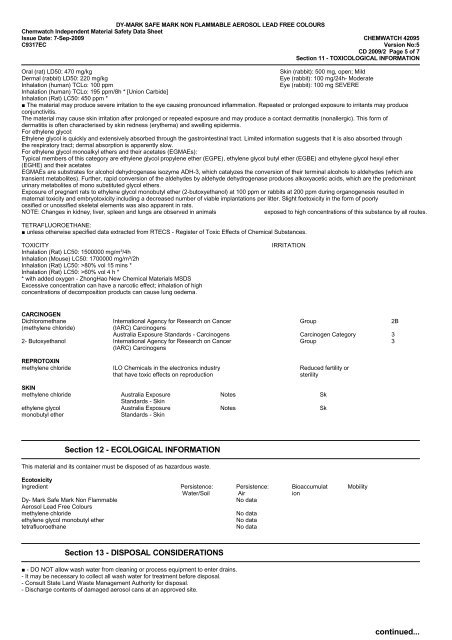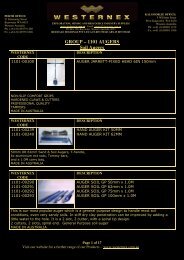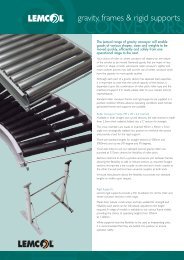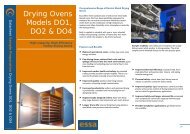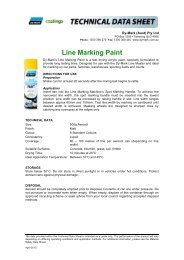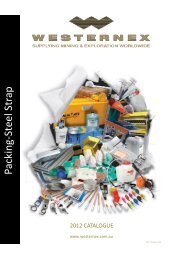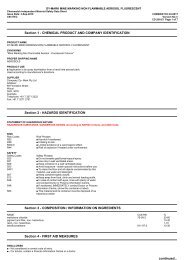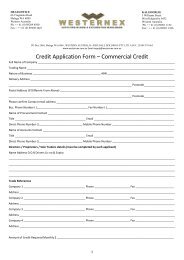Chemwatch Australian MSDS 42095 - Westernex
Chemwatch Australian MSDS 42095 - Westernex
Chemwatch Australian MSDS 42095 - Westernex
You also want an ePaper? Increase the reach of your titles
YUMPU automatically turns print PDFs into web optimized ePapers that Google loves.
DY-MARK SAFE MARK NON FLAMMABLE AEROSOL LEAD FREE COLOURS<br />
<strong>Chemwatch</strong> Independent Material Safety Data Sheet<br />
Issue Date: 7-Sep-2009 CHEMWATCH <strong>42095</strong><br />
C9317EC<br />
Version No:5<br />
CD 2009/2 Page 5 of 7<br />
Section 11 - TOXICOLOGICAL INFORMATION<br />
Oral (rat) LD50: 470 mg/kg Skin (rabbit): 500 mg, open; Mild<br />
Dermal (rabbit) LD50: 220 mg/kg<br />
Eye (rabbit): 100 mg/24h- Moderate<br />
Inhalation (human) TCLo: 100 ppm<br />
Eye (rabbit): 100 mg SEVERE<br />
Inhalation (human) TCLo: 195 ppm/8h * [Union Carbide]<br />
Inhalation (Rat) LC50: 450 ppm *<br />
■ The material may produce severe irritation to the eye causing pronounced inflammation. Repeated or prolonged exposure to irritants may produce<br />
conjunctivitis.<br />
The material may cause skin irritation after prolonged or repeated exposure and may produce a contact dermatitis (nonallergic). This form of<br />
dermatitis is often characterised by skin redness (erythema) and swelling epidermis.<br />
For ethylene glycol:<br />
Ethylene glycol is quickly and extensively absorbed through the gastrointestinal tract. Limited information suggests that it is also absorbed through<br />
the respiratory tract; dermal absorption is apparently slow.<br />
For ethylene glycol monoalkyl ethers and their acetates (EGMAEs):<br />
Typical members of this category are ethylene glycol propylene ether (EGPE), ethylene glycol butyl ether (EGBE) and ethylene glycol hexyl ether<br />
(EGHE) and their acetates<br />
EGMAEs are substrates for alcohol dehydrogenase isozyme ADH-3, which catalyzes the conversion of their terminal alcohols to aldehydes (which are<br />
transient metabolites). Further, rapid conversion of the aldehydes by aldehyde dehydrogenase produces alkoxyacetic acids, which are the predominant<br />
urinary metabolites of mono substituted glycol ethers.<br />
Exposure of pregnant rats to ethylene glycol monobutyl ether (2-butoxyethanol) at 100 ppm or rabbits at 200 ppm during organogenesis resulted in<br />
maternal toxicity and embryotoxicity including a decreased number of viable implantations per litter. Slight foetoxicity in the form of poorly<br />
ossified or unossified skeletal elements was also apparent in rats.<br />
NOTE: Changes in kidney, liver, spleen and lungs are observed in animals<br />
exposed to high concentrations of this substance by all routes.<br />
TETRAFLUOROETHANE:<br />
■ unless otherwise specified data extracted from RTECS - Register of Toxic Effects of Chemical Substances.<br />
TOXICITY<br />
IRRITATION<br />
Inhalation (Rat) LC50: 1500000 mg/m³/4h<br />
Inhalation (Mouse) LC50: 1700000 mg/m³/2h<br />
Inhalation (Rat) LC50: >80% vol 15 mins *<br />
Inhalation (Rat) LC50: >60% vol 4 h *<br />
* with added oxygen - ZhongHao New Chemical Materials <strong>MSDS</strong><br />
Excessive concentration can have a narcotic effect; inhalation of high<br />
concentrations of decomposition products can cause lung oedema.<br />
CARCINOGEN<br />
Dichloromethane International Agency for Research on Cancer Group 2B<br />
(methylene chloride)<br />
(IARC) Carcinogens<br />
Australia Exposure Standards - Carcinogens Carcinogen Category 3<br />
2- Butoxyethanol International Agency for Research on Cancer Group 3<br />
(IARC) Carcinogens<br />
REPROTOXIN<br />
methylene chloride ILO Chemicals in the electronics industry Reduced fertility or<br />
that have toxic effects on reproduction<br />
sterility<br />
SKIN<br />
methylene chloride Australia Exposure Notes Sk<br />
Standards - Skin<br />
ethylene glycol Australia Exposure Notes Sk<br />
monobutyl ether<br />
Standards - Skin<br />
Section 12 - ECOLOGICAL INFORMATION<br />
This material and its container must be disposed of as hazardous waste.<br />
Ecotoxicity<br />
Ingredient Persistence: Persistence: Bioaccumulat Mobility<br />
Water/Soil Air ion<br />
Dy- Mark Safe Mark Non Flammable<br />
No data<br />
Aerosol Lead Free Colours<br />
methylene chloride<br />
No data<br />
ethylene glycol monobutyl ether<br />
No data<br />
tetrafluoroethane<br />
No data<br />
Section 13 - DISPOSAL CONSIDERATIONS<br />
■ - DO NOT allow wash water from cleaning or process equipment to enter drains.<br />
- It may be necessary to collect all wash water for treatment before disposal.<br />
- Consult State Land Waste Management Authority for disposal.<br />
- Discharge contents of damaged aerosol cans at an approved site.<br />
continued...


